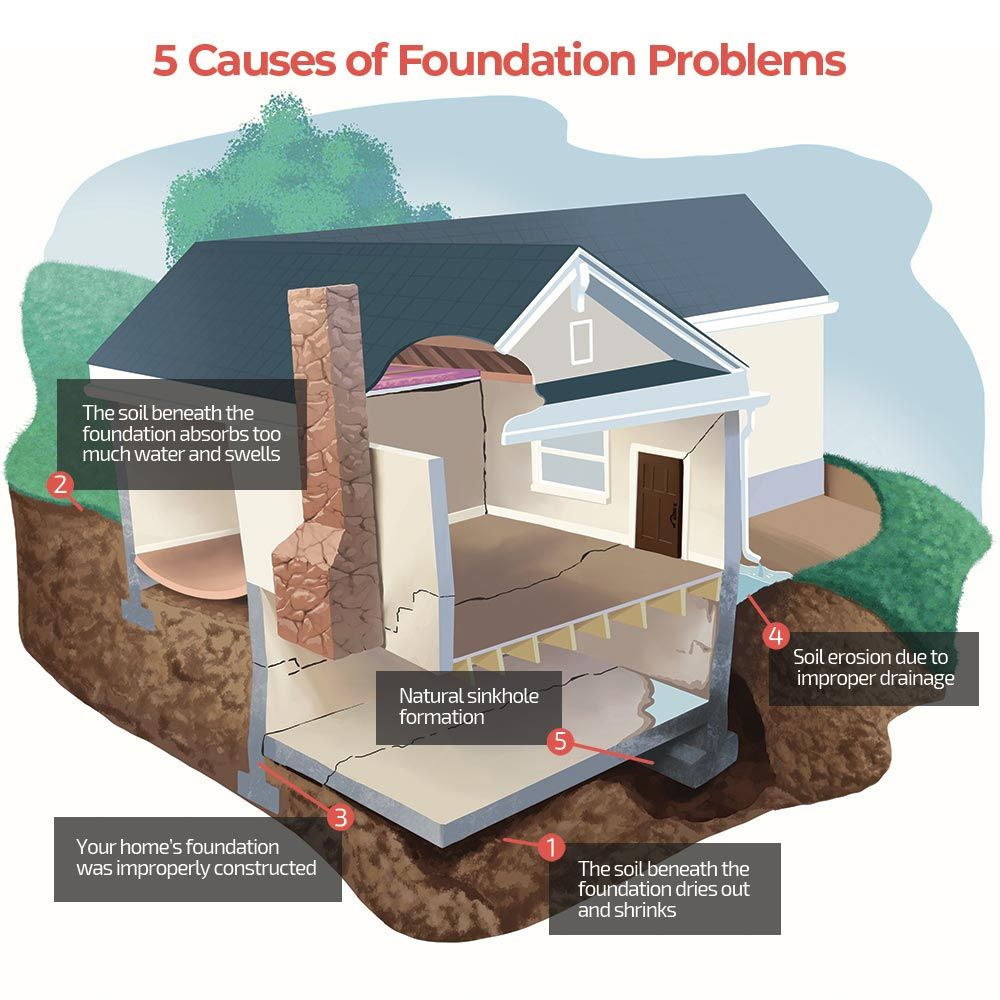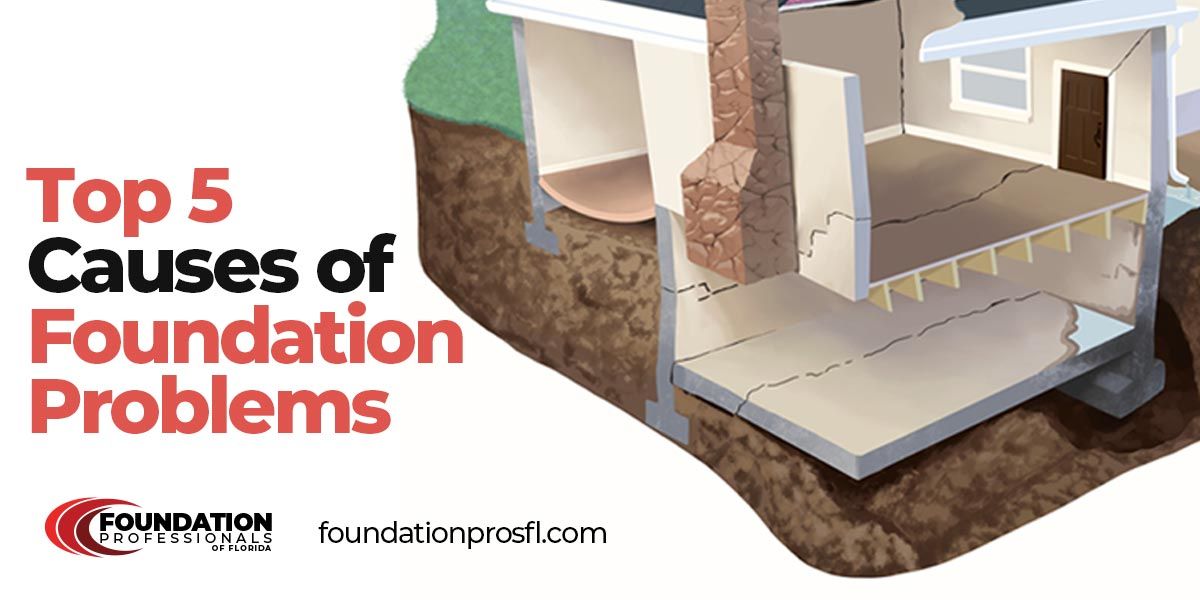Your home’s structural integrity literally rests on its foundation. If you ignore a minor problem with your foundation, it could turn into a major catastrophe that could cost you thousands of dollars to fix. As the adage goes, an ounce of prevention is worth a pound of cure, and this is especially true when it comes to foundations.
It might surprise you, but…
Most foundation problems are caused by water. If there’s too much water, the soil will swell, and if there’s too little, the soil will shrink. Both situations can cause problems with your home’s foundation, primarily when the swelling or shrinkage is concentrated in one area of the foundation. In other words, if the soil under the foundation isn’t evenly wet or dry. Soil erosion caused by improper drainage can also lead to problems with your home’s foundation. We’ll talk more about these issues below.
Of course, water isn’t the only reason foundations fail. The Leaning Tower of Pisa’s foundation was too shallow (only about 10 feet deep) and built atop unstable soil. We all know what happened.
Before we get into the top three causes of foundation issues, we need to talk a bit about expansive soils.
What you need to know about expansive soils
Expansive soils (soils that contain smectite clay minerals swell the most) are those that can absorb and release water. When this happens, they expand and shrink, often quite a bit.
And therein lies the problem.
This moisture absorption and release-process cause volume changes in the soil. This is perfectly OK if the soil under the structure is evenly wet or dry. In this case, the structure’s foundation will move as one unit as the soil expands or shrinks.
However, what if the soil under the foundation isn’t evenly wet or dry?
When certain areas of the soil under the foundation are dryer (or wetter) than others, the foundation no longer moves as one unit as the soil expands or shrinks. When this happens, the foundation can develop cracks and other serious problems.
Expansive soils are present throughout the US and Canada, and in the US, they cause $2.3 billion in damage every year.
So, now that we have that out of the way, let’s take a look at the top five causes of foundation problems.

1.The soil beneath the foundation dries out and shrinks
During hot, dry weather, the soil under your foundation shrinks as it dries out. When this happens, the support provided by the soil pulls away from the foundation, and this makes it unstable and more inclined to shift. When the foundation shifts, you start to see things like cracks in walls, ceilings, floors, and even problems with opening doors and windows.
Soil can also dry out because tree roots suck water from it. The soil then shrinks, pulls away from the foundation, and you start to have problems that can result in severe structural damage.
If you live in an area with expansive soils, like Northern and Central Florida, it’s essential to water both your lawn and your trees during hot, dry weather. This will prevent the soil from drying and pulling away from the foundation. However, as you will see in the next section, you want to make sure the soil does not get overly saturated in wet or rainy seasons.
2.The soil beneath the foundation absorbs too much water and swells
Your foundation can also develop problems if the soil underneath it contains too much water. As we’ve noted above, when the soil gets saturated with water, it swells and expands. This pushes upward on the foundation and can cause cracks in walls, floors, ceilings, etc. Your floors might even begin to slope because of this upward movement.
Too much moisture in one area can compact or erode loose, granular soils (or cause them to settle), which leads to uneven support under the foundation. In an area with expansive soil, too much moisture will – as we explained above – cause the soil to expand.
Too much moisture can also cause soil erosion—more on this below.
So, how does this happen? Where does all this water come from?
It comes from a variety of sources, including plumbing leaks, broken sewer lines, heavy rainfall, melting snow, or floods.
Surface water should always flow away from the foundation. Gutters and downspouts should be kept free of debris so that water doesn’t overflow near the foundation. French drains can also be installed if your property has an issue with water pooling by the foundation (more on this later).
3.Your home’s foundation was improperly constructed
So, as we’ve seen, the soil swells as it absorbs water and shrinks as it releases water. This is especially true of clay soil, which is quite common in the midwestern region of the US. Clay soil swells a lot when it absorbs water and then shrinks when it releases the moisture considerably. This back and forth – extreme swelling and shrinking – puts a lot of stress on a foundation.
Problems can also happen when your home is built on top of more than one type of soil. For example, if your home is built on top of two different soils, one that holds water very well and one that doesn’t. This can cause differential settlement, which can then lead to structural damage.
So, what if there’s clay or different types of soil in the area where you want to build?
One solution is to strengthen the soil using a chemical grout injection, which solidifies loose soil.
Another solution is to install pre-construction helical piles/piers for projects that require deep foundations. The piers work to transfer the structure’s load to the soil that can better support it.
Finally, poor soil preparation and compaction by the foundation contractor can also cause problems.
4.Soil erosion due to improper drainage
Inadequate drainage around your home can lead to over-saturation of the soil, which can then cause soil erosion. When this happens, your home’s foundation can destabilize. Walls might buckle, the building might start to tilt, etc. Dangerous underground voids can even develop due to soil erosion.
Drainage problems can be caused by a number of things, including, but certainly not limited to…
- Water running off rooftops and then pooling near your foundation.
- Clogged gutters and downspouts are causing the same. Downspouts need to be angled properly, so water doesn’t pool near the foundation and destabilize the soil. Downspout extensions will also help you keep water from pooling near the foundation.
- Low areas in your yard close to the foundation collect water after heavy rains. This standing water can slowly erode the supporting soil layers and limestone beneath the surface and cause sinkholes to form.
You can avoid these problems by making sure water always flows away from your home, not toward it. French drains and other types of water run-off systems are a couple of possible solutions to drainage problems.
5.Natural sinkhole formation
Sinkholes are caused by water draining underground. That is, without having an external drainage outlet. When this happens, it causes subterranean soil erosion that can lead to the development of underground caverns.
Even small sinkholes can cause severe problems with your home’s foundation. So, it’s essential to be able to recognize the presence of sinkholes early. Signs of sinkhole activity include…
- Trees or other vertical structures such as poles and fence posts that are starting to tilt
- Difficulty closing doors and windows.
- Water bills that are higher than usual indicate there may be a leak in underground water supply lines.
- Areas of ground that are soft and spongy. Check especially the area around anything that’s tilting.
- Tree roots don’t cause cracked sidewalks or driveways that you know.
- Indentations and sunken areas in the lawn or under pavers.
Read more about – Foundation leak repair
How you can prevent problems with your home’s foundation
Provided your home’s foundation was properly constructed, there are a few simple things you can do to prevent problems with its foundation…
- Evenly water your lawn during hot/dry weather if you live in an area with expansive soil.
- Water large trees near your home.
- Make sure water drains away from your foundation during the rainy season.
- Keep plumbing, gutters, downspouts, etc. in proper working order.
- After heavy rains, inspect your property for pooled water. If you have any drainage problems in those areas, fix them.
- Make sure underground drains and water supply lines are free from leaks.
- If you own a swimming pool, make sure the pressurized water lines don’t leak.
The structural integrity of your home is only as good as the foundation it sits on. Provided your home’s foundation was constructed correctly, it’s relatively easy to either prevent problems or catch them before they have a chance to do significant damage. For more information, see 11 Signs Of Foundation Failure.

